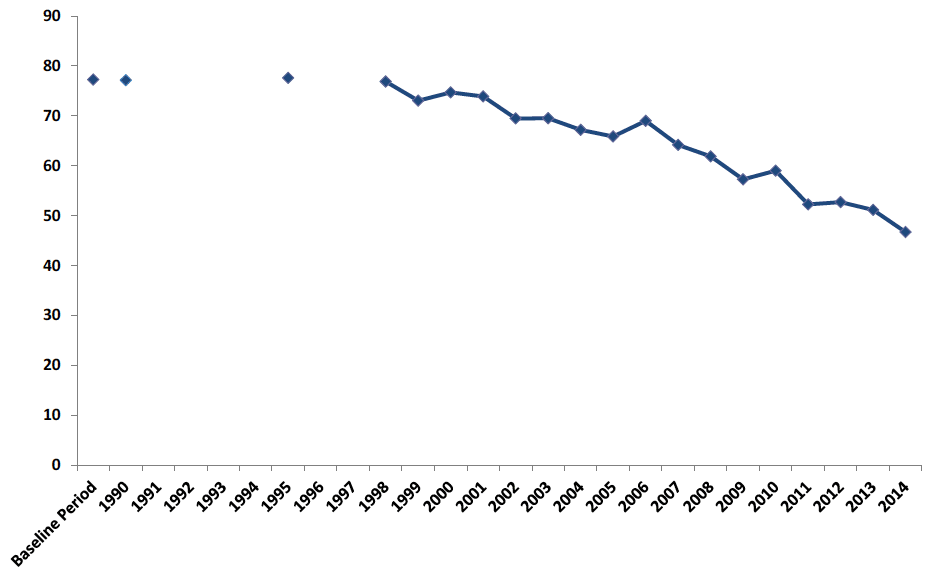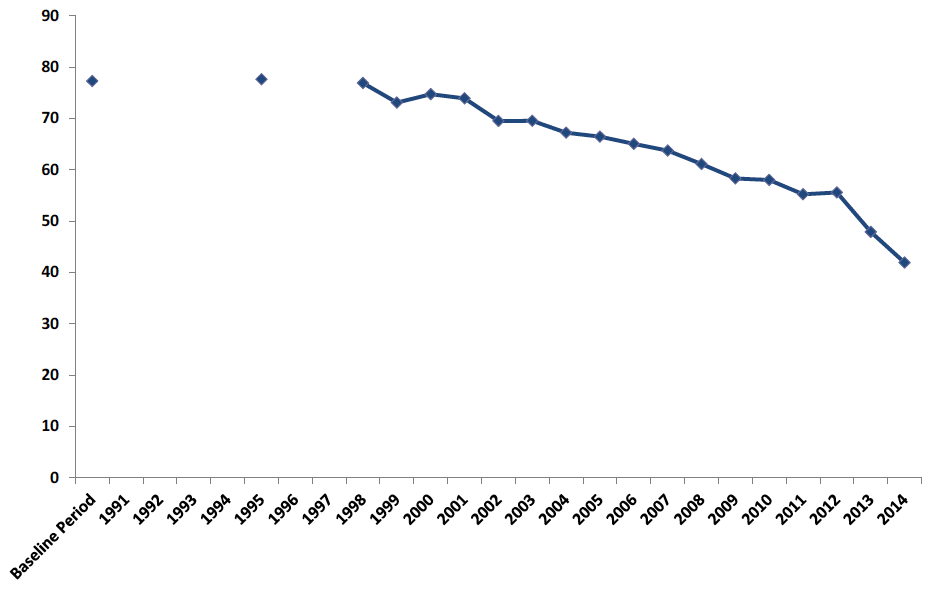Scottish Greenhouse Gas Emissions 2014
This publication provides estimates of greenhouse gas emissions in Scotland for the years 1990 to 2014.
Scottish Greenhouse Gas Emissions 2014
There are two measures of greenhouse gases presented in this release:

Section A of this release states what the greenhouse gases are, how they are categorised and when to use source and adjusted emissions. Section B contains results in more detail. Section C provides an explanation of how and why there are differences between the source and adjusted emissions. Section D contains information on revisions to the greenhouse gas statistics.
KEY TREND - SOURCE EMISSIONS
Scottish Greenhouse Gas Emissions, 1990 to 2014. Values in MtCO 2e

In 2014, Scottish emissions of the basket of seven greenhouse gases are estimated to be 46.7 million tonnes carbon dioxide equivalent ( MtCO 2e). This is 8.6 per cent lower than the 2013 figure of 51.1 MtCO 2e, a 4.4 MtCO 2e decrease.
The 2 main contributors to this reduction between 2013 and 2014 are:
- Fall in Energy Supply emissions (such as power stations) (2.1 MtCO 2e; 13.4 per cent reduction)
- Fall in Residential Emissions (such as space heating of homes) (1.2 MtCO 2e; 16.4 per cent reduction)
Between 1990 and 2014, there was a 39.5 per cent reduction in estimated emissions, a 30.5 MtCO 2e decrease.
The 2 main contributors to this reduction are:
- Fall in Energy Supply emissions (such as Power stations) (8.9 MtCO 2e; 39.2 per cent reduction)
- Fall in Waste Management Emissions (such as Landfill) (7.6 MtCO 2e; 77.3 per cent reduction)
Section A states what the greenhouse gases are and how they are categorised. Scotland's net source emissions are comprised of sources of greenhouse gas emissions and sinks, which remove greenhouse gases from the atmosphere. Section B contains results in more detail. In particular, charts B2 , B5 and B6 provide more information about individual sectoral trends.
KEY TREND - EU ETS ADJUSTED EMISSIONS
Scottish Greenhouse Gas Emissions, Adjusted for the EU Emissions Trading System, ( EU ETS). 1990 to 2014. Values in MtCO 2e

- When emissions are adjusted to take account of trading in the EU Emissions Trading System ( EU ETS), emissions decreased by 12.5 per cent between 2013 and 2014 (from 47.9 MtCO 2e to 41.9 MtCO 2e). This is the basis against which progress towards the targets outlined within the Climate Change (Scotland) Act 2009 are measured.
- The EU ETS is an EU policy aimed at mitigating climate change by limiting greenhouse gas emissions from large point source emitters (primarily electricity generation and energy-intensive industries) and in aviation. Under accounting rules of the Climate Change (Scotland) 2009 Act, the contribution of those sectors to the annual targets is determined by the Scottish share of emissions allowances in the EU ETS, rather than the actual level of emissions. Section C provides information on what the EU ETS is and what it means for Scotland's Greenhouse Gas Emissions statistics.
- Compared with the Baseline Period [1] , emissions in 2014 (after taking account of trading in the EU ETS) were 45.8 per cent lower. Section A contains more information on how the Baseline Period is defined and Section C contains results in more detail.
- In both 2013 and 2014, Scotland's EU ETS adjusted emissions showed a drop from the previous year. This is because the amount of available emissions allowances in the EU ETS at a UK and EU-wide level is much lower than previously and this is reflected in the Scottish figures.
REVISIONS TO GREENHOUSE GAS EMISSIONS STATISTICS
Note that as part of this release all of the figures have been revised since the previous publication in June 2015, to incorporate methodological improvements and new data. Comparing the 2014 figures with the 2013 figures published a year ago will therefore give a different year-on-year percentage change; one which is incorrect and should not be used. Details of these revisions can be found later in this statistical release in Section D.
Contact
There is a problem
Thanks for your feedback